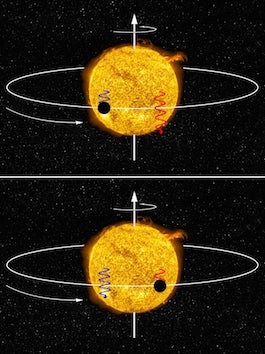For millennia scientists and observers have learned from our Sun and other stars that move throughout the night sky. The life and death of stars teaches us about star formation, solar system formation and occasionally fills on those odds and ends questions about how we came to be. Depending on what they’re searching for, stars like our Sun can help modern day scientists discover other planetary bodies, like exoplanets. One of the main ways they do this is by using telescopes like Kepler that looks for a dimming of the light curve as a planet transits across the plane of the star.
The bane of exoplanet hunter’s existence is the sunspot. Our sun goes through cycles and sunspots can easily be seen with a solar telescope of even solar eclipse glasses. But a sunspot can be there one day, and gone the next. If a telescope like Kepler is examining a star looking for planets and a sunspot is present on the surface that will affect the amount of photons hitting its spectrometer, and could lead to false positives.
However, understanding these strange planetary bodies from these extreme distances can prove challenging. Recently researches at the University of Porto in Portugal and Institute of Astrophysics of Georg-August-University of Göttingen published a paper in the journal of Astronomy and Astrophysics showing that the normal activity of stars could be the reason why some exoplanet angles appear extremely misaligned.
Using the Rossiter-McLaughlin effect, or RM effect, exoplanet researchers measure the spin-orbit tilt of exoplanets, which is a factor in determining a specific planetary migration model. They want to know if the planet formed cleanly inside the planetary nebula, or migrated inward after forming in the outer reaches, accounting for a discombobulated arrangement.
The RM effect measures the amount of doppler effected light coming from the star. Using spectroscopic wavelengths of light they measure the amount of red and blue photons coming from the host star. If looking head on at a star like our Sun, it will spin in one direction — if it spins in a clockwise motion, the right side of the star will look slightly red-shifted as it moves away from us and the side spinning towards us will look slightly more blue-shifted. When a planet passes in front of its star, it will block out either more red or blue light, depending on its size and the angle in which it’s orbiting.
Planet formation is a tricky business and it can happen in a myriad of ways. Many planets orbit at a relatively normal angle, but some can be tilted a full 90 degrees, or pole-on as they orbit their star. These extreme tilts tell scientists a lot about how these planets formed, and how their host solar system formed.
“This angle is very important because it is a window into the past,” says co-author Pedro Figueira from the University of Porto. “It lets us know if the planet is likely to have been formed in a disk and migrated in smoothly through gravitational interaction, or formed violently around other planets or stars. In the first case we have a small misalignment angle, in the second one a large one.”
One of the biggest issues scientists have when searching for these exoplanets is stellar activity of the planet’s host star. As we know from our Sun, stars can be quite active, creating sunspots, ejecting plasma out into space, and displaying brighter spots on the surface called “plages” which are convecting areas that appear to be red-shifting as the material moves deeper into the star. All of these normal stellar behaviors interfere with the amount of red and blue light reaching the observer, and in turn can interfere with the spectra data being collected from the telescope.
One way around this is to study the stars of interests for months or even years to predict their surface patterns. “This study is a part of a growing body of work pointing to how crucial the understanding of solar activity is when it comes to interpreting exoplanet results,” says Dr. Sarah Ballard, exoplanetary researcher at MIT. “It has a context of a growing movement within exoplanet research of how stellar activity bears upon radial velocity observations, transits and RM measurements.”
The team hopes that their findings will inform future research and how instruments are designed on upcoming observatories. “These results will make us rethink a bit the way we derive these angles, and will be more conservative on the errors assigned to each spinning angle,” says Figueira.While this likely won’t negate any previous results, it could help explain the anomalies that still exist in the catalog of wonky exoplanets and hopefully help scientists better understand how they form in the first place.










